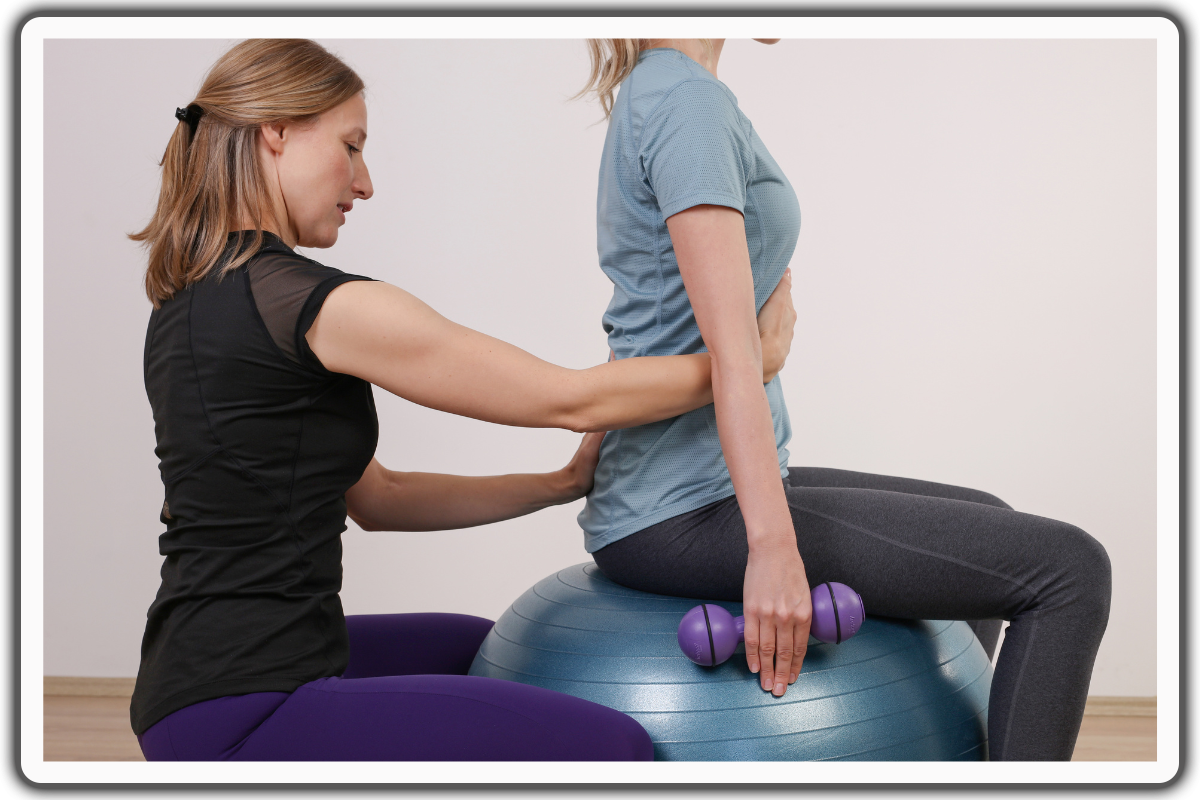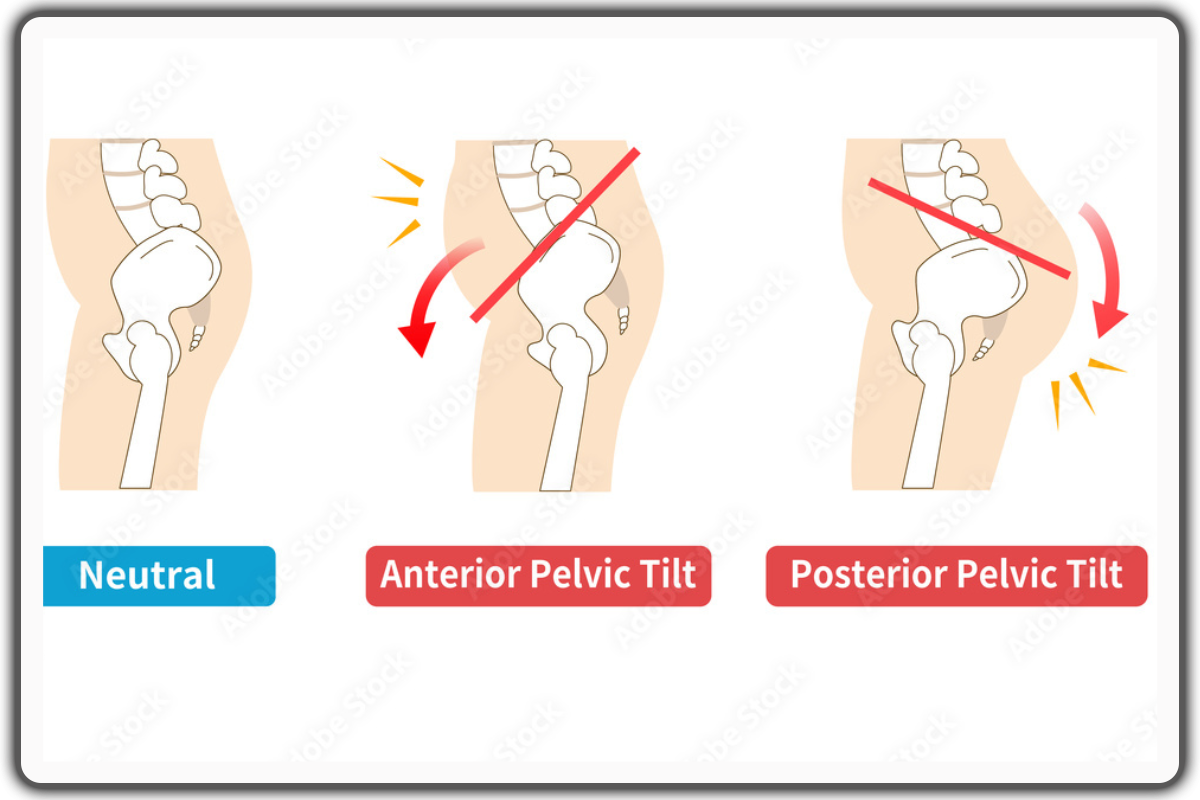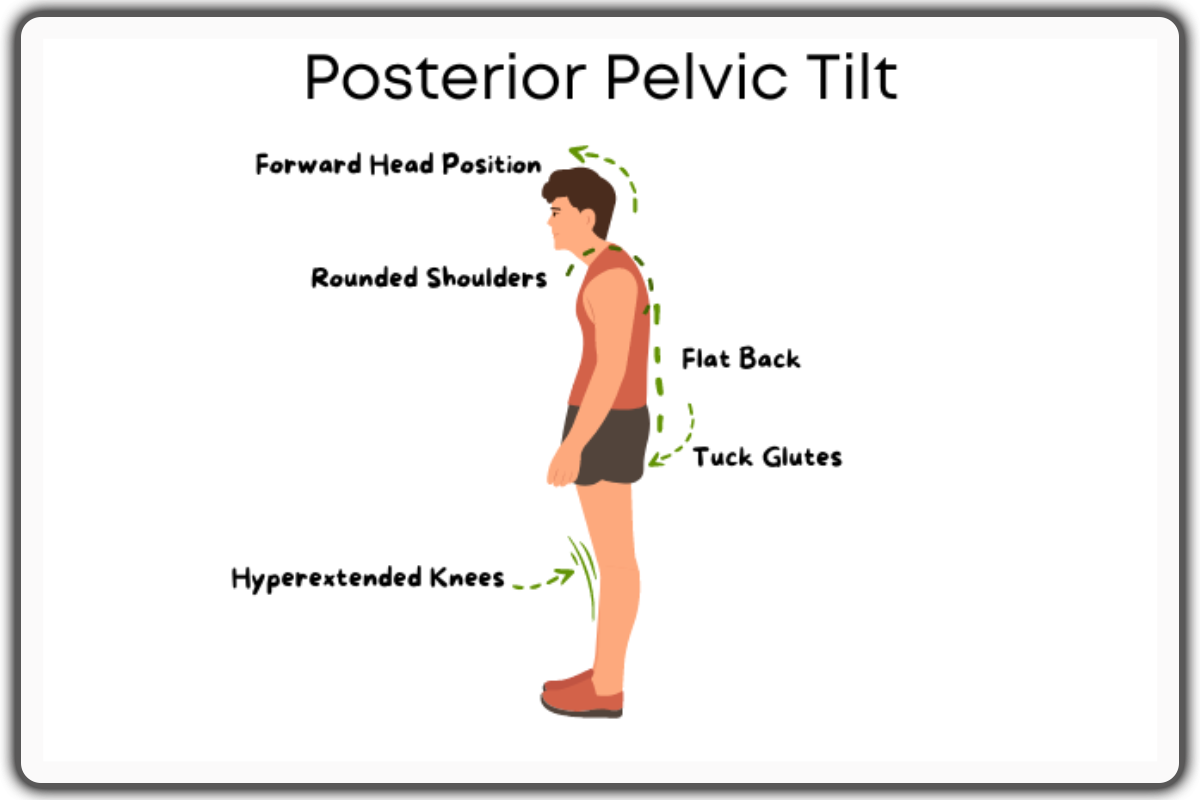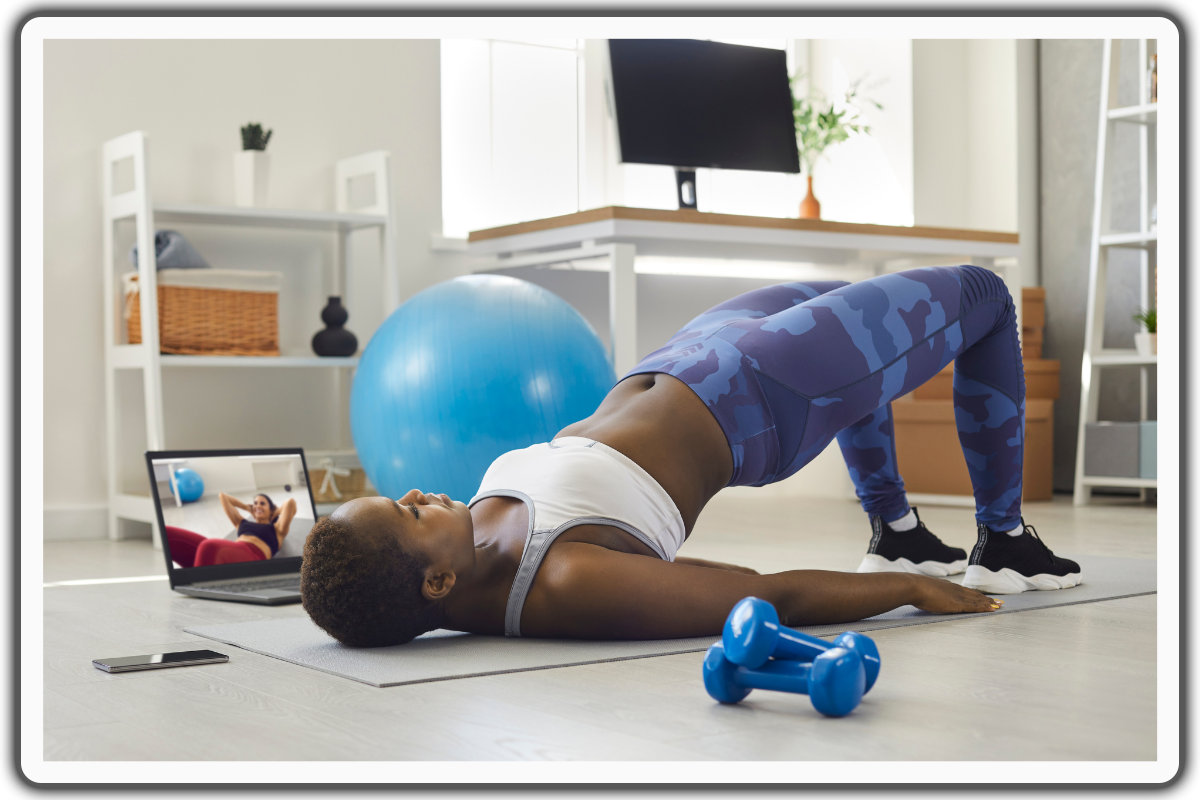
Unlocking Better Posture: Understanding Posterior Pelvic Tilt
In our modern sedentary lifestyles, maintaining proper posture is crucial for overall health. One common issue that arises due to prolonged sitting and poor posture is posterior pelvic tilt. But what exactly is it, and how can we address it effectively?
In this article, we delve into the mechanics of posterior pelvic tilt, explore its signs and causes, and provide practical tips and exercises to correct posterior pelvic tilt. Whether you’re an office worker, fitness enthusiast, or simply curious about improving your posture, read on to discover valuable insights and actionable steps.
Causes

A posterior pelvic tilting [³] occurs due to an imbalance between the muscles in the legs and the core. The muscles involved include the glutes, hamstrings, quadriceps, pelvic floor muscles, abdominal muscles, diaphragm, and deep back muscles. Several factors contribute to this condition, which can affect overall posture and movement efficiency:
- Poor Posture: Consistently slouching while standing or sitting can affect the alignment of the spine and pelvis. Poor standing posture, where the spine does not maintain its natural curves, can lead to the flattening of lumbar lordosis (the inward curve of the lower back), contributing to a posterior pelvic tilt.
Sleeping Habits: Sleeping positions, particularly sleeping on your stomach, can exacerbate the issue. This position can place stress on the lower back and sacroiliac joints, promoting an unnatural pelvic tilt.
Lack of Movement: Sedentary lifestyles lead to muscle weakness and tension. Prolonged sitting, especially without proper ergonomic support, can cause the hip flexors to shorten and the hamstrings to tighten, contributing to pelvic imbalance.
Hamstring Tightness: Tight hamstrings are a significant factor in posterior pelvic tilt. When the hamstrings are tight, they pull on the pelvis, tilting it backward. This chronic tightness can develop from prolonged sitting or lack of flexibility exercises.
Weak Core Muscles: The core muscles, including the abdominal muscles, pelvic floor muscles, and diaphragm, play a crucial role in maintaining pelvic alignment. Weakness in these muscles can result in an inability to stabilize the pelvis correctly, leading to a posterior tilt.
Imbalanced Muscle Strength: An imbalance between the strength of the glutes and the hip flexors can cause a posterior pelvic tilt. Strong hip flexors and weak glutes can pull the pelvis out of alignment. Conversely, an anterior pelvic tilt, where the pelvis tilts forward, can also cause issues but typically involves different muscle imbalances.
Injury or Trauma: Previous injuries or trauma to the lower back, pelvis, or sacroiliac joints can result in compensatory patterns that affect the alignment of the pelvis.
Understanding these factors is important for addressing and correcting posterior pelvic tilt. Strengthening and stretching the appropriate muscles, improving posture, and incorporating proper movement patterns into daily activities and exercise routines can help alleviate this condition.
Symptoms

Posterior pelvic tilt is a condition where the pelvis tilts backward, leading to various symptoms and signs. Here are the common ones:
- Flattened Lumbar Spine: The lower back appears more straight or flattened instead of having its natural inward curve.
Tucked Glutes: The buttocks seem less prominent as the gluteal muscles appear tucked under.
Forward Head Position: The head juts forward to compensate for the pelvic misalignment.
Tight Hamstrings: The back of the thighs feel tight and shortened.
Weak Hip Flexors and Lower Back Muscles: Muscles in the front of the hips and lower back weaken over time.
Lower Back and Hip Discomfort: Misalignment causes discomfort or pain in the lower back and hips.
Changed Walking Pattern: A shifted pelvis position leads to an uneven or awkward gait.
Hyperextended Knees: The knees extend backward more than normal when standing.
Reduced Hip and Lower Back Mobility: There is a decrease in the overall range of motion in the hips and lower back
Addressing posterior pelvic tilt typically involves targeted exercises to strengthen weak muscles, stretch tight muscles, and improve overall posture and body mechanics. Consulting a physical therapist or healthcare provider is advisable for a tailored treatment plan to fix posterior pelvic tilt.
According to Dr. Gregory Minnis, DPT, strengthening the hip flexors and lower back muscles while stretching tight hamstrings and glutes can effectively help correct posterior pelvic tilt. A regular and focused exercise routine can improve posture, reduce discomfort, and restore functional movement patterns.
Disadvantages of Posterior Pelvic Tilt
Posterior pelvic tilt can lead to several disadvantages that affect both physical health and daily activities. Here are some key disadvantages:
1. Reduced Mobility
- Hip and Lower Back Movement: The misalignment of the pelvis can restrict the natural movement of the hips and lower back, making activities like walking, bending, and lifting more challenging.
2. Chronic Pain and Discomfort
Lower Back Pain: The flattening of the lumbar spine and the altered posture can lead to chronic lower back pain.
Hip Pain: The tightness in the hip flexors and hamstrings can cause hip pain and discomfort.
3. Poor Posture
- Forward Head Posture: To compensate for the pelvic misalignment, the head may jut forward, leading to poor posture and potential neck strain.
Flattened Lumbar Curve: The natural curve of the lumbar spine is lost, leading to a less supportive spinal structure.
4. Muscle Imbalances
- Weak Core Muscles: The weakness in the core muscles due to poor alignment can lead to further instability and imbalance.
Tight Hamstrings and Hip Flexors: Persistent tightness in these muscles can exacerbate the posterior pelvic tilt and make it harder to correct.
5. Impact on Athletic Performance
Reduced Strength and Power: The imbalance between different muscle groups can reduce overall strength and power, impacting athletic performance.
Decreased Flexibility: Tight muscles and restricted movement can decrease flexibility, making it harder to perform certain exercises and movements.
6. Altered Gait and Balance
Walking Pattern: The shifted pelvis position can lead to an uneven or awkward gait, potentially causing further strain and imbalance.
Balance Issues: The overall imbalance in muscle strength and posture can affect balance, increasing the risk of falls and injuries.
7. Increased Risk of Injury
Joint Strain: The misalignment can put extra stress on the joints, raising the risk of injuries, especially in the hips, lower back, and knees.
Compensatory Injuries: Other parts of the body may compensate for the poor alignment, leading to injuries in areas like the neck, shoulders, and upper back.
8. Respiratory Concerns
Restricted Chest Expansion: Posterior pelvic tilt can limit the expansion of the thoracic (chest) area [¹], reducing the ability to take deep breaths.
Decreased Lung Capacity: The altered posture can lead to decreased lung capacity and reduced overall respiratory function.
Breathing Difficulties: Tightness in the thoracic region and poor alignment can make breathing more laborious and less efficient, potentially leading to shortness of breath during physical activities.
Common Groups Affected by Posterior Pelvic Tilt
Posterior pelvic tilt commonly affects sedentary individuals, particularly:
- Office workers and students who sit for prolonged periods can develop muscle imbalances, such as weakened hip flexors and tight hamstrings.
Older adults are at higher risk due to age-related muscle decline.
People with poor posture habits, certain athletes who focus on specific muscle groups without balancing their training,
Individuals with pre-existing musculoskeletal conditions like scoliosis or hip dysfunctions are more susceptible.
Pregnant women may experience posterior pelvic tilt due to changes in body mechanics and posture, especially postpartum.
Understanding the risk factors is critical for early identification and intervention through targeted exercises, posture correction, and lifestyle adjustments.
Posterior Pelvic Tilt Treatment
Treating posterior pelvic tilt involves a combination of pelvic tilt exercises, stretches, and lifestyle adjustments aimed at correcting muscle imbalances and improving posture. Here are some strategies:

Exercises to Strengthen Weak Muscles:
- Hip Flexor Strengthening: Perform exercises like leg raises and seated marches to strengthen the hip extensors and flexors.
- Lower Back Strengthening: Engage in activities such as back extensions and bridges to build lower back strength.
- Core Strengthening: Incorporate upper body exercises, planks, abdominal crunches, and other core exercises to support pelvic stability.
Stretches to Loosen Tight Muscles:
- Hamstring Stretching: Practice hamstring stretches, such as standing toe touches or lying hamstring stretches, to alleviate tightness.
- Gluteal Muscle Stretching: Perform stretches like pigeon pose and seated figure-four stretch to loosen the gluteal muscles.
- Lower Back Stretching: Use lower back stretches, such as child’s pose and cat-cow stretch, to improve flexibility.
Posture and Ergonomics:
- Improve Sitting Posture: Ensure proper ergonomic setup when sitting, with feet flat on the floor, knees at hip level, and the back supported.
- Adjust Workstation: Modify your workstation to promote good posture [²], using a chair with lumbar support and positioning the monitor at eye level.
- Frequent Movement: Avoid prolonged sitting or standing; take regular breaks to move and stretch throughout the day.
Professional Assistance:
- Physical Therapy: Consult a physical therapist for a personalized exercise and stretching program tailored to your specific needs
- Chiropractic Care: A chiropractor can help realign the pelvis and spine, reducing discomfort and improving posture.
- Massage Therapy: Regular massage can help release tight muscles and improve flexibility. intege lectus semper vestib laoret portti.
Lifestyle Modifications:
- Regular Exercise: Engage in regular physical activity to maintain muscle balance and overall health.
- Weight Management: Maintain a healthy weight to reduce strain on the lower back and pelvis.
- Awareness and Mindfulness: Be mindful of your posture throughout the day, making a conscious effort to avoid slouching or improper alignment.
By incorporating these strategies, you can effectively address posterior pelvic tilt, improve your posture, and alleviate associated discomfort. Consulting healthcare professionals can provide additional guidance and support tailored to your individual needs.
Conclusion
Addressing hip concerns such as posterior pelvic tilt is crucial for maintaining overall health and mobility. Proper hip alignment supports a healthy spine, reduces discomfort, and prevents further musculoskeletal issues.
By focusing on exercises that strengthen weak muscles, stretching tight areas, and maintaining good posture, we can correct imbalances and enhance our physical well-being.
Maintaining a healthy and mobile body not only alleviates pain but also improves our quality of life, enabling us to perform daily activities with ease and reducing the risk of injury.
Prioritizing hip health through proactive measures fosters a more active, pain-free lifestyle, allowing us to enjoy life's moments with greater comfort and confidence, contributing to long-term wellness and vitality.
FAQ's
What is the main cause of posterior pelvic tilt?
Posterior pelvic tilt is mainly caused by muscle imbalances, especially tight hamstrings and weak hip flexors or core muscles. Prolonged sitting, poor posture, and lack of physical activity can all contribute to these imbalances, resulting in the pelvis tilting backward.
Can posterior pelvic tilt affect my breathing?
Yes, it can. A posterior pelvic tilt can limit the expansion of the thoracic (chest) area, which may reduce lung capacity and make breathing less efficient, especially during physical activity.
How can I fix posterior pelvic tilt at home?
You can address posterior pelvic tilt at home by combining targeted strengthening exercises (like glute bridges, leg raises, and planks) with stretches (such as hamstring and lower back stretches). Modifying your workstation to promote proper posture is also key
Who is most at risk of developing posterior pelvic tilt?
People who sit for long periods, such as office workers and students, are most at risk. Older adults, individuals with poor posture habits, and those recovering from injuries or dealing with muscular imbalances are also commonly affected.
Why is posture correction important for posterior pelvic tilt?
Improving posture helps realign the pelvis, reduce strain on muscles and joints, and prevent further complications. It also supports better movement, reduces pain, and enhances overall body mechanics—helping you feel and move better throughout the day.
References
1. Aramaki, Y., Kakizaki, F., Kawata, S., Omotehara, T., & Itoh, M. (2021). Effects of the posterior pelvic tilt sitting posture on thoracic morphology and respiratory function. Journal of Physical Therapy Science, 33(2), 118-124. https://doi.org/10.1589/jpts.33.118
2. Bridger, R. S. (1991). Some fundamental aspects of posture related to ergonomics. International Journal of Industrial Ergonomics, 8(1), 3-15. https://doi.org/10.1016/0169-8141(91)90021-D
3. Lowe, W. (2003). Posterior pelvic tilt. In Orthopedic Massage. Retrieved from https://www.sciencedirect.com/topics/nursing-and-health-professions/posterior-pelvic-tilt
